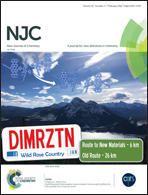1,1-Difluoro-3-aryl(heteroaryl)-1H-pyrido[1,2-c][1,3,5,2]oxadiazaborinin-9-ium-1-uides: synthesis; structure; and photophysical, electrochemical, and BSA-binding studies†
Abstract
This paper presents a series of six examples of 1,1-difluoro-3-aryl(heteroaryl)-1H-pyrido[1,2-c][1,3,5,2]oxadiazaborinin-9-ium-1-uides (2)—in which aryl(heteroaryl) = phenyl, 4-MeC6H4, 4-N(CH3)2C6H4, 4-NO2C6H4, 2-naphthyl, and 2-thienyl—as pyridine-based boron heterocycles with variable ligand structures. The heterocycles 2 were easily synthesized at yields of 51–70% from reactions—at room temperature for 24 h—of simple N-(pyridin-2-yl)benzamides (1) with BF3·Et2O, and they were fully characterized by 1H-, 13C-, 19F-, and 11B-NMR spectroscopy, GC-MS, and X-ray diffractometry. The optical and electrochemical properties of 2 (UV-vis spectra, fluorescence spectra, quantum yield calculations, Stokes’ shifts, redox potentials, and DFT calculations) were determined and discussed. BSA-binding experiments and molecular docking studies of new complexes 2 were performed and correlated between each other.
![Graphical abstract: 1,1-Difluoro-3-aryl(heteroaryl)-1H-pyrido[1,2-c][1,3,5,2]oxadiazaborinin-9-ium-1-uides: synthesis; structure; and photophysical, electrochemical, and BSA-binding studies](/en/Image/Get?imageInfo.ImageType=GA&imageInfo.ImageIdentifier.ManuscriptID=C7NJ04032F&imageInfo.ImageIdentifier.Year=2018)


 Please wait while we load your content...
Please wait while we load your content...